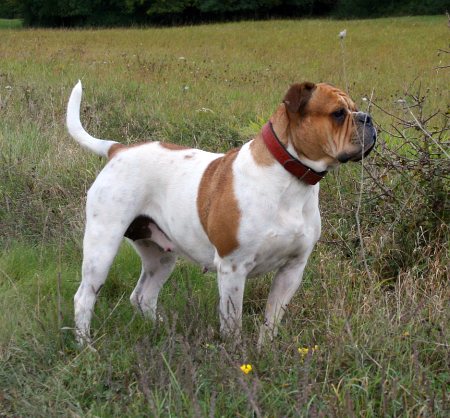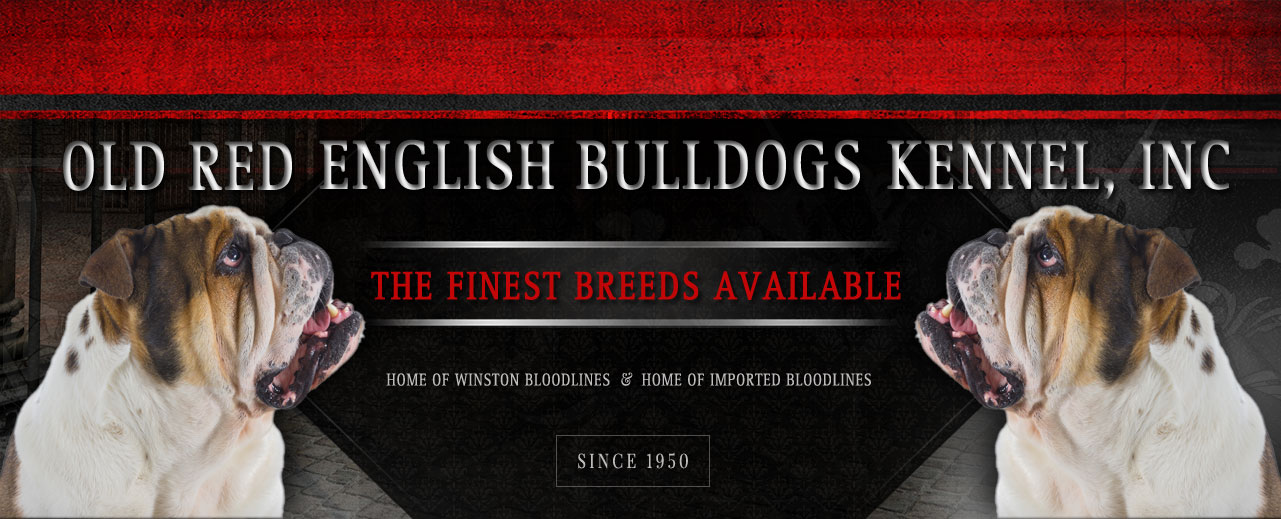 Standard – Olde English Bulldogges, Olde Bulldogges, Working Bulldogges
Standard – Olde English Bulldogges, Olde Bulldogges, Working Bulldogges
GENERAL APPEARANCE
The Olde English Bulldogge is a muscular, medium to large-sized dog known for its strength, stability, and athleticism. It is well-balanced and proportioned, with no exaggerated features. The breed was developed in the early 1970s by David Leavitt in Coatesville, PA, using a line-breeding scheme designed by Ohio State University for breeding cattle. The goal was to recreate the look, health, and athleticism of the original bull-baiting Bulldogs without their extreme tenacity. The foundation crosses included ½ English Bulldog and the other half made up of Bullmastiff, American Pit Bull Terrier, and American Bulldog. Through these careful planned crosses, the Olde English Bulldogge was created and began to breed true.
CHARACTERISITCS
The Olde English Bulldogge has a confident, courageous, and alert disposition. They are friendly and loving, but due to their strength, they can occasionally show same-sex dog aggression. Therefore, socialization and obedience training are important for this breed. High-energy individuals should be given an outlet for their energy through work and exercise.
Fault: Shyness in a mature dog.
HEAD –
TThe Olde English Bulldogge has a prominent and dramatic head, with a circumference at least equal to its height at the withers. Its large, well-developed cheeks showcase powerful jaw muscles, and a slightly wrinkled forehead is acceptable.
SKULL –
The skull of the Olde English Bulldogge is large but well proportioned to its muscular body and prominent shoulders, featuring a distinct crease running from the stop to the occiput.
Serious Faults:
Narrow skull; domed forehead.
MUZZLE –
The muzzle of the Olde English Bulldogge is square, wide, and deep, with a definite layback. The distance from the tip of the nose to the stop does not exceed one-third of the distance from the tip of the nose to the occiput. The muzzle’s height, from the bottom of the chin to the top, is equal to or greater than its length, creating a deep, square appearance. There is a slight to moderate wrinkle on the muzzle, and the flews are semi-pendulous. The bite is undershot and horizontally straight, with an underbite of ¾ inch or less. The lower jawbone is moderately curved from front to back.
Faults:
A slightly longer or shorter muzzle; excessive wrinkle.
Disqualifications: Wry jaw; overbite.
EYES –
The eyes of the Olde English Bulldogge are round to almond-shaped and medium-sized. They are set wide apart, with the outer corners aligning with the outside line of the skull. Positioned low at the level of the muzzle, they intersect where the stop and muzzle meet. Eye color is brown, with black pigmented eye rims.
Fault:
Any pink on the eye rims.
Disqualifications: Any eye color other than brown; wall eyes; crossed eyes.
TEETH –
Canine teeth are large. Broken, chipped or extracted teeth are acceptable. There are 6 corn row teeth between canines.
Fault: Exposed canine teeth
NOSE-
The nostrils of the Olde English Bulldogge are wide, with a distinct vertical line running from the tip of the nose down to the bottom of the upper lip. The nose is large and broad, proportionate to the width of the muzzle, and always black in color.
Faults:
Any pink on the nose or in the nostrils.
Serious Fault: Slit nostrils
Disqualification:
Any color nose other than black
EARS –
The ears of the Olde English Bulldogge can be rose, button, or tulip, with rose being the preferred type. They are set high and toward the rear of the skull, positioned as wide as possible on the outside of the skull. The ears are small to medium in size.
NECK –
The neck of the Olde English Bulldogge is of medium length, wide, and slightly arched. It is slightly smaller than the head where they meet and gradually widens toward the shoulders. The skin is slightly loose from the jaw to the chest, forming a double dewlap.
Serious Fault: A single dewlap.
SHOULDERS –
The shoulders of the Olde English Bulldogge are broad, heavily muscled, and exhibit a noticeable separation between the shoulder blades. The scapula (shoulder blade) is positioned at approximately a 35-degree angle to vertical and forms an angle of about 110 degrees with the humerus (forearm). The scapula and humerus should be roughly equal in length.
ELBOWS –
A vertical line drawn from the point of the scapula (top) to the ground will pass directly through the elbow. The elbows are not turned in or out.
FORELEGS –
The forelegs are set wide apart and come straight down from the shoulders. They are straight on the inside of the legs and well-muscled, giving the front quarters a slightly bowed appearance. The forelegs have medium bone and are proportional to the body.
PASTERNS –
The pasterns are medium in length. They are straight, strong, flexible and nearly perpendicular to the ground.
Faults: Foreleg bones too heavy or too light.
Serious Faults:
Loose shoulders; upright shoulders; loose elbows; weak pasterns (either too vertical or too horizontal).
BODY –
Body is sturdy and powerful. The length from tip of breastbone to rear thigh is slightly longer than the height from ground to withers.
BACK –
The back of the Olde English Bulldogge is wide and muscular, showcasing strength and power. The top-line features a slight roach or wheel back, with a slight fall behind the shoulders that leads to the low spot. From there, the spine rises toward the loin, with the high point of the loin sitting slightly higher than the shoulders. This leads to a gentle curve down to the tail, forming a smooth arch. The loin, which extends from the back of the rib cage to the hips, is muscular, medium in length, and slightly arched.
CHEST –
The chest is wide and deep with a muscular brisket. Ribs are well sprung and rounded, being at their fullest directly behind the shoulders. Shoulders to forelegs are well muscled.
Faults:
Narrow rib cage. Very long or short loin.
HINDQUARTERS –
The hips and thighs of the Olde English Bulldogge are strong and muscular, with the hind legs being well muscled and slightly longer than the forelegs. When the dog is standing naturally, the hind legs are straight, parallel, and set apart when viewed from the rear. The distance between the hind legs is narrower than the distance between the front legs. The angulation is moderate, with the stifles displaying a gentle convex curve when viewed from the side. The angle of the stifle roughly matches that of the pelvis. The hocks are perpendicular to the ground when viewed both from the side and the back, and they are parallel to one another from the back. A line drawn from the rear most part of the buttocks, perpendicular to the ground, should fall to the front of the toes. A line drawn from the upper point of the pelvis, perpendicular to the ground, should pass through the knee, ensuring proper angulation.
Fault:
Hips which are equal to shoulders in width.
Serious Faults:
Straight stifle. Severely cow hocked or bow hocked.
FEET –
Feet are of medium size and are well arched and rounded (cats’ foot). They are straight when viewed from the front. Rear feet are smaller than front feet.
Faults: Feet turning in or out; long toes.
Serious Faults:
Flat feet; hare feet; and splayed toes.
TAIL –
Set low, thick at the root, tapering to a point. Tail should not curl over back. No Docking of the tail, it helps the dog balance so he can move while working.
Faults:
Tail curling 360 degrees. Same circumference from base to tip.
Disqualifications:
Kinked, docked, bobbed or screw tail (a kinked tail is a tail with one or more sharp bends).
COAT –
Coatis short, close and of medium density. It should be shiny, showing good health.
Faults:
Fringe, feather or curl in the coat.
COLOR –
Color can be brindle of red, mahogany, fawn or black; either solid or pied (with white). Solid white. Fawn, red or black; solid color or pied.
Disqualifications:
Blue (Neapolitan Mastiff color), as well as black with rust or mahogany (Rottweiler colors)
HEIGHT and WEIGHT –
Males are 60 to 80 lbs. and 17 to 20 inches at the withers; Bitches are 50 to 70 lbs. and 16 to 19 inches at the withers.
Deviation from this range of height and weight will be faulted according to the extent of the deviation.
Weight should be proportioned to height and the dogs must not be squat nor rangy.
GAIT –
The gait of the Olde English Bulldogge is smooth, powerful, energetic, and confident. When the dog moves, it travels straight, with the feet moving forward and back in the same plane. As the trot speed increases, the footfalls approach the centerline. There is a slight understep, with the rear feet landing just short of where the front feet land. The front and rear reach are balanced, ensuring the dog moves fluidly without crossing or interfering with its feet. Proper movement is displayed when viewed from both the side and back, showcasing the breed’s athleticism and balance.
These are the Bulldogs and Mastiffs we breed and sell.
The pictures on each page are for identification purposes and OldBulldogs.com does not own every animal pictured. These pages are informational and intended to describe the standards of each breed.
- Alano Español
- Alapaha Blue Blood Bulldogs
- American Bandogge Mastiffs
- American Bully-Bullies
- American Pit Bull Terriers
- American Staffordshire Bullies
- American Staffordshire Terriers
- Arkansas Giant Bulldogs
- Australian Bandogge Mastiffs
- Australian Bulldogs
- American Bulldogs-Old Time Southern Bulldogs-Old Southern Whites
- Banter Bulldogs
- Boxer Bulldogs
- Bull Terriers
- Bull Mastiffs
- Miniature Bull Terriers
- Mexican Bulldogs
- Miniature English Bulldogs
- Neapolitan Mastiffs
- Old Boston Bulldogs
- Olde English Bulldogges
- Old Victorian Bulldogs
- Patterdale Terrier
- Perro de Presa Canario
- Performance-Standard Type American Bulldogs
- Perro de Presa Mallorquin
- Panja Mastiffs
- Renascence Bulldogs
- South African Boerboel
- Staffordshire Bull Terriers
- Saint Bernard
- Valley Bulldogs
- Winston Working Bulldogs
- Winston’s Working Mastiffs
- Winston’s Working Terriers
- Winston’s Working Hounds
- Winston’s Working Shepherds
